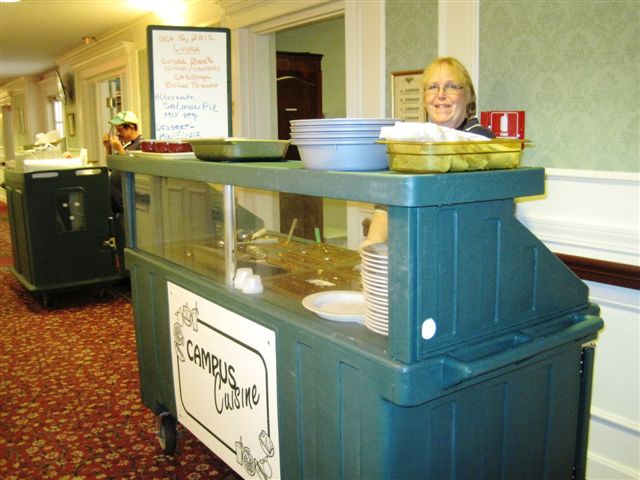Deinstitutionalized dining in LTC
Winchester Rehabilitation and Nursing Center, a 121-bed Salter Healthcare facility in Winchester, Mass., has moved to trayless dining. Chief Operating Officer Robert Driscoll wanted Salter Healthcare facilities to eliminate institutionalized tray service, so Renato Deleon, dining service director, and I began by researching who was doing trayless service, and what equipment was out to initiate it.
CHANGING THE DINING CULTURE
Our journey began several years ago, starting with steam table service in one dining room for one meal a day. Breakfast is served in the main dining room from the steam table to each individual’s preference, and this has greatly enhanced the quality of life at Winchester. As a result of that success, all dining rooms began serving all meals seven days a week from the hot steam service.
 However, residents who chose to eat in their rooms were still served on trays. It is a system that has been around for a long time and it served its purpose. But we wanted to provide more food options, serve hot foods hot and cold foods cold, increase delicious aromas and improve presentation. We also needed to do this while being cost effective.
However, residents who chose to eat in their rooms were still served on trays. It is a system that has been around for a long time and it served its purpose. But we wanted to provide more food options, serve hot foods hot and cold foods cold, increase delicious aromas and improve presentation. We also needed to do this while being cost effective.
TAKING AWAY THE TRAYS
Our Dining Services Director Deleon visited St. Camillus in Whitinsville, Mass., to observe the operation of its trayless system and returned full of enthusiasm, instilling that enthusiasm into the staff. A committee was formed and a slide show and PowerPoint presentation outlined the positive attributes that a trayless system would add to our dining program. Besides the deinstitutionalized dining that this program offered with the wonderful smells wafting off of the cuisine carts, we also felt that appetites would benefit as well as resident’s weights would increase. The service would add a new level of participation between dining staff and residents, with meals being delivered hot off the cart by the same people who prepare and deliver the food.
The goal was to create a program that embraced the standards of culture change. This first and foremost is about teamwork. This program is not one that can succeed with only kitchen staff changing the way they get the food out. Cross-training all staff is crucial to success.
While promoting staff buy-in, we reviewed the costs involved in the conversion and how this could be done in times of cuts and cutbacks. We chose a foodservicesystem with insulated compartmentsthat could maintain both hot and cold foods at the proper temperatures. Service was carefully planned around timing and temperatures, considering what areas received delivery first and second. To supplement the service, we purchased two rolling food stations and two additional carts for drinks and cereals. We customized the cart with pizza stones, chillers and made adjustments to the carts for toasters, thermometers and temperature sheetsto ensure customer satisfaction and meet regulations. Additional carts accompany the larger trolleys and hold coffee, tea, milk, bananas, yogurts, cold cereals, etc.
Our staff educator and nursing director visited St. Camillus a few months later, while we were in the planning stages. Our Activity and Environmental Services personnelattended the feeding assistant program approved by the Massachusetts Department of Public Health (DPH) in preparation for creating an “all hands on deck” program.
BENEFITS OF TRAYLESS SERVICE
 By eliminating tray service there is a shorter wait from time of order to point of service, no calls to the kitchen seeking product and more interaction between dietary services and residents. Dietary services and nursing have worked closely and created a team environment. Customer satisfaction skyrocketed through the roof and residents have been given back their options.
By eliminating tray service there is a shorter wait from time of order to point of service, no calls to the kitchen seeking product and more interaction between dietary services and residents. Dietary services and nursing have worked closely and created a team environment. Customer satisfaction skyrocketed through the roof and residents have been given back their options.
In addition to the elevated resident satisfaction with the new food delivery system, there were cost savings achieved along the way as shown in the chart below.
Savings with trayless foodservice.
Per patient day | January 2012 | August 2012 | Savings |
Labor | $12.76 | $11.41 | $1.35 |
Raw Food | $8.77 | $7.33 | $1.44 |
In a six-month period, a savings of $1.44 per patient, per day, was achieved. The amount of staff was actually decreased by one FTE (40 hours a week) putting us at $1.35 savings per patient, per day.
Who is happy about the changes? Resident Council has given “two thumbs up” for better temperatures, food tastes and service. Residents’ weights have improved from a facility average of 4–5 percent to 2-3 percent and under.The DPH was happy with the system, and families and staff have expressed satisfaction as well. The Dining Committee continues to meet to improve service and identify education needs.
Shelley Silverman King is the Executive Director at Winchester Rehabilitation and Nursing Center in Winchester, Mass. To contact her, email Shelley.king@salterhealthcare.com.
I Advance Senior Care is the industry-leading source for practical, in-depth, business-building, and resident care information for owners, executives, administrators, and directors of nursing at assisted living communities, skilled nursing facilities, post-acute facilities, and continuing care retirement communities. The I Advance Senior Care editorial team and industry experts provide market analysis, strategic direction, policy commentary, clinical best-practices, business management, and technology breakthroughs.
I Advance Senior Care is part of the Institute for the Advancement of Senior Care and published by Plain-English Health Care.
Related Articles
Topics: Articles , Executive Leadership , Nutrition











